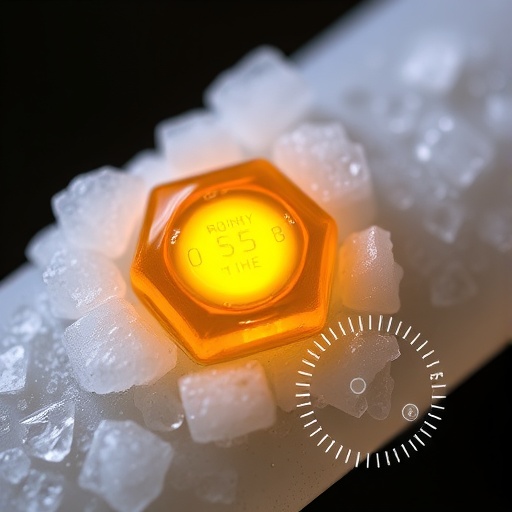In the realm of personal health monitoring, sweat has emerged as a promising diagnostic fluid, offering a noninvasive window into the body’s biochemical status. Although predominantly composed of water, sweat contains a complex mixture of electrolytes, metabolites, and chemical compounds that can reveal critical health information. Among the various biomarkers measurable in sweat, lactic acid—or more specifically, L-lactate—has garnered attention due to its significant role in metabolism and exercise physiology. Recent breakthroughs from researchers at the Tokyo University of Science have shed new light on how to enhance the functionality and reliability of lactic acid sensors for sweat analysis, paving the way for more robust continuous monitoring devices.
L-lactate is primarily produced in muscle cells under anaerobic conditions, where oxygen is scarce, and glucose metabolism shifts accordingly. This metabolic byproduct accumulates during intense physical activity, making lactate concentration a valuable indicator of muscle fatigue, endurance capacity, and overall physiological stress. Athletes, trainers, and clinicians alike have shown interest in measuring sweat lactate as a minimally invasive alternative to blood-based assays, with applications extending to heatstroke monitoring and metabolic disorder diagnostics such as lactic acidosis.
At the core of most lactic acid sensors lies the enzyme lactate oxidase (LOx), which selectively catalyzes the oxidation of lactate into pyruvate, concomitantly producing hydrogen peroxide (H2O2) as an electroactive byproduct. The electrochemical detection of this generated peroxide forms the basis for quantifying lactate levels. Yet, a significant hurdle arises owing to the enzyme’s inherent instability under acidic conditions. Sweat’s naturally low pH—typically around 4.0—degrades LOx activity, thus compromising sensor accuracy and longevity. Addressing the enzyme’s pH sensitivity is critical for realizing sweat sensors capable of stable, long-term performance in real-world applications.
Conventional strategies have often involved incorporating sugars as stabilizing agents to protect LOx from acid-induced denaturation. However, these approaches often fall short in maintaining sufficient enzyme activity when confronted with the harsh acidic environment of sweat. The pioneering research team at Tokyo University of Science, led by Associate Professor Isao Shitanda, has demonstrated that sucrose monolaurate, a sucrose-based amphiphilic molecule, remarkably outperforms typical sugars by preserving LOx activity even in highly acidic media.
In controlled experiments simulating sweat’s acidity, electrodes modified with sucrose monolaurate maintained approximately 80% of LOx activity at pH 5.0. This marks a substantial improvement over electrodes lacking stabilizers, which only retained about 50% activity, and those treated with maltose, which showed minimal enhancement under comparable acidic conditions. These findings underscore the critical protective role of sucrose monolaurate in extending enzyme lifespan and preserving sensor sensitivity.
To unravel the protective mechanism behind sucrose monolaurate’s efficacy, the research harnessed grazing incidence small-angle X-ray scattering (GI-SAXS), an advanced characterization technique capable of probing nanoscale surface architectures. GI-SAXS investigations revealed that sucrose monolaurate assembles into highly ordered hexagonal arrays accompanied by lamellar (layered) structures on the electrode surface. Within these architectures, lactate oxidase molecules become embedded, effectively encapsulated in a nanostructured protective matrix.
At the molecular level, sucrose monolaurate’s amphiphilic nature promotes the formation of core-shell micelles that transition into rod-like shapes, packing densely into hexagonal configurations. This arrangement creates a selective barrier: it impedes the ingress of disruptive protons (hydrogen ions) responsible for enzyme deactivation while permitting the passage of essential molecules such as water and lactic acid. Consequently, the enzyme remains operational, shielded from the detrimental acidification that would otherwise compromise its function.
The novelty of this approach lies not only in enzyme stabilization but also in maintaining sensor responsiveness—a crucial balance between shielding and permeability. By forming this nanostructured protective layer, sucrose monolaurate enables the electrode to faithfully transduce lactic acid concentrations, ensuring accuracy and reliability over prolonged sensing periods in sweat.
Such advancements hold profound implications for the development of wearable biosensors tailored to continuous health and fitness monitoring. Reliable real-time measurement of sweat lactate can empower athletes to optimize training regimens, alert to impending heat-related illnesses, and even aid in medical diagnostics. The scalability and safety of sucrose monolaurate further enhance its appeal as a commercial stabilizer, heralding a new generation of durable, enzyme-based biosensors.
Moreover, the broader scientific community can extrapolate this stabilization strategy to other enzymes and environmental challenges. The self-assembling nanostructures responsive to external conditions suggest a versatile platform for designing biocompatible coatings that safeguard enzyme activity across diverse biochemical applications, including environmental sensors and biofuel cells.
The dedication of the Tokyo University of Science team, composed of experts in electrochemistry and physical chemistry, highlights the power of multidisciplinary collaboration. Their study was not only published in the prestigious journal Langmuir but also recognized with accolades such as the Supplemental Cover of Langmuir in 2025 and ranking among the most downloaded papers of 2024. These honors reflect the significance and broad interest in their findings.
This research was bolstered by funding from the Japan Society for the Promotion of Science, emphasizing the strategic importance Japan places on advancing technology with tangible health benefits. As the demand for personalized, noninvasive health monitoring grows, innovations such as enzyme stabilization on wearable sensors will bridge the gap between laboratory prototypes and consumer-ready devices.
In sum, the work led by Dr. Isao Shitanda presents an elegant, structurally-informed solution to a longstanding problem in enzymatic biosensing under acidic conditions. By leveraging the supramolecular organization of sucrose monolaurate, the researchers have engineered a robust enzyme-electrode interface that ensures both stability and sensitivity. This breakthrough not only advances sweat lactate detection but also sets a precedent for future explorations in biosensor design, promising a future where continuous, accurate biomonitoring is seamlessly integrated into daily life.
Subject of Research: Not applicable
Article Title: Sucrose Monolaurate as a Stabilizer for Lactate Oxidase Electrodes At Low pH: A Structural Analysis Based on Grazing Incidence Small-Angle X‑ray Scattering
News Publication Date: 5-Aug-2025
References: DOI: 10.1021/acs.langmuir.5c02857
Image Credits: Credit: Dr. Isao Shitanda from Tokyo University of Science, Japan
Keywords: Health and medicine, Health care, Sports, Chemical engineering, Physical sciences, Life sciences, Applied sciences and engineering




